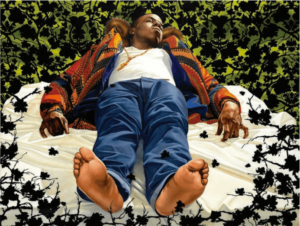
Lamentation over the Dead Christ (Kehinde Wiley/Le Petit Palais)
A Black artist known for creating reversals of European art is displaying his pieces in a Paris museum.
France’s Le Petit Palais issued a press release detailing the exhibit, which launched Oct. 20.
Kehinde Wiley’s art took on Christian imagery but replaced it with Black faces. In his first solo exhibition, Wiley will showcase 10 monumental works speaking to the current plight of Black people and police brutality. Six of those pieces are stained glass and four are paintings. All are currently on display at Petit Palais through January 15, 2017.
Many of Wiley’s works challenge the white power structure by focusing on Black victims. For example, his version of “Madonna and Child” replaces Mary with a Black woman in a green Adidas track jacket. As she stares with her hands on her hips and a crown on her head, a Black child stands between her legs. Rather than sitting passively, the mother is assertive.

Madonna and Child (Kehinde Wiley/Le Petit Palais)
Wiley’s piece is drastically different from the Christian images by Italian painters like Giovanni di Marco and Filippo Lipp. Those versions of “Madonna and Child” show Mary cuddling baby Jesus, according to the New World Encyclopedia.
And a 2008 take on “The Lamentation Over The Dead Christ,” shows a Black man dead in a field of grass. The man wears a t-shirt and jeans complete with a gold chain and jacket. Wiley’s image directly comments on the slain Black men in the streets of America, their lives ended by police.
The Black man’s resting place contrasts with that of Christ in a painting of the same name by Italian Renaissance artist Andrea Mantegna. In that piece, Christ is seen in a bed as two mourners look on, according to the Independent. However, for Wiley’s piece, his victim lies alone.
The images fall in line with Wiley’s 15-year-long creations of contemporary African-American art. According to the description of his self-titled monograph, Wiley began by shooting photos of men in Harlem, New York, blending various artistic styles. His first exhibition debuted in 2001 when he first gained attention for flipping the racial power structure.
